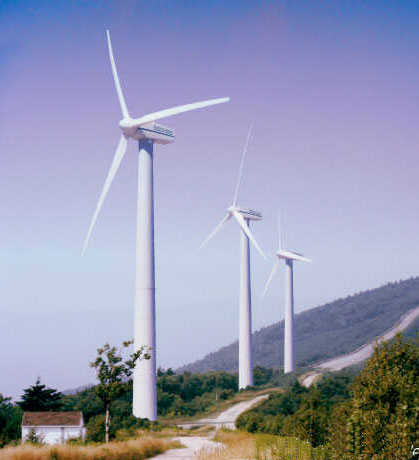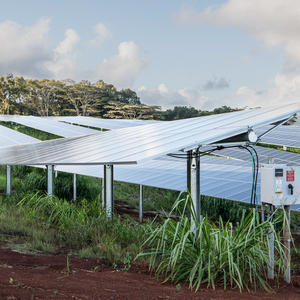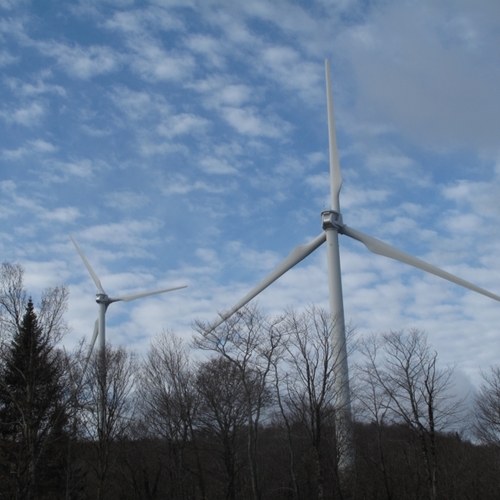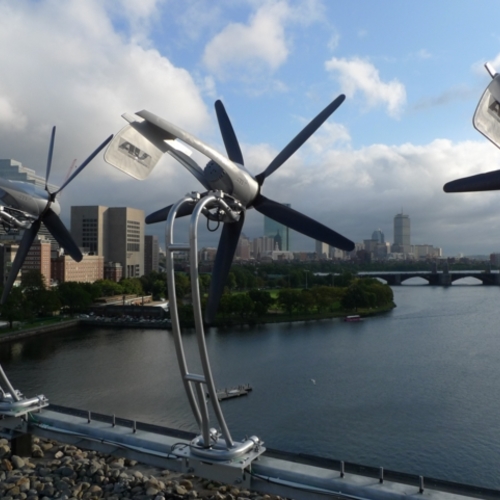
Last week we reviewed the history of wind energy, including its use for pumping water and generating power. This week we’ll take at look at the state of the art with wind power and what’s ahead.
The growth of wind power over the past decade has been nothing short of spectacular. In ten years, from 1998 to 2008, installed world wind energy capacity increased more than 12-fold, from 9,700 megawatts (MW) to 121,000 MW, according to the World Wind Energy Association. During the same period, U.S. wind power capacity increased nearly 13-fold, from 1,946 to 25,170 MW. Having been the world leader in wind power until 1997, the U.S. lost that position to Germany for the next ten years, but recaptured the world leadership in 2008, with a remarkable 49.7% increase in capacity over 2007. This is still just a tiny percentage of our total power generation, but it’s increasing faster than other energy source.
The vast majority of this growth has been not in individual wind turbines for homes or businesses, but in utility-scale “wind farms” that aggregate multiple wind turbines and feed the electricity into the utility grid. By locating multiple wind turbines near each other, operation and maintenance can be much more efficient. The first large wind farms were built in the 1980s in California, in some particularly windy mountain areas, such as Tehachapi Pass and Altamont Pass, where thousands of wind turbines were installed. By today’s standards, these early turbines were tiny—often just 35 kilowatts (kW) in capacity.
In the past decade, most of the installed capacity of wind power has been with far larger wind turbines—some as large as 3 MW (nearly 100 times as large as those installed in California in the ’80s). With wind power, there is a significant economy of scale—bigger is better. This is partly because larger wind turbines are taller, reaching 300 or 400 feet into the sky where wind speeds are significantly greater than they are near ground level. But these new, larger turbines also benefit from the latest in aerodynamic design so they’re more efficient, and, per unit of output, they are much less expensive. According to Tony Rogers, senior engineer at the wind energy consulting firm DNV Global Energy Concepts, state-of-the-art wind turbines are up to 51% efficient—meaning they convert over half of the energy in the intercepted wind into electricity (by comparison, photovoltaic panels convert less than one-quarter of the sunlight striking them into electricity).
Another advantage to larger machines is that the blades rotate at slower speeds. While the blades of a 35-kW wind turbine in a stiff breeze will be a nearly invisible blur, the blades of a 1 MW machine will be readily visible as they spin. This results in far fewer bird fatalities—admittedly a significant concern in California’s wind farms from the 1980s. Bird fatalities from today’s MW-scale wind turbines are very low.
While I am a huge fan of wind power, it’s important to be honest about the limitations of this form of power generation. When a coal-fired or nuclear power plant is rated at 1,000 MW, we can be confident that it will operate most of the time with that power output. Utility folks refer to the “capacity factor,” or the amount of power produced over a given period of time compared with the amount that would have been produced had the plant operated at its rated output for that entire period. The average capacity factor of coal plants in the U.S. is 74% and for nuclear plants 92%, while most wind farms have capacity factors of just 25-40%, due to the intermittent nature of wind. Thus, replacing a 1,000 MW coal-fired power plant with wind would take 2,000–3,000 MW of wind power capacity, and even then the power output often will not match the electricity demand.
To be able to distribute electricity from wind, there needs to be a robust distribution network. Because wind farms are, by their very nature, spread out and often in remote areas, the cost of this distribution can be expensive. In the U.S., the plains states have the greatest wind resource, but the greatest demand for electricity is on the east and west coasts. (One of the components on the just-passed stimulus package is funding to improve the nation’s power grid—in part to facilitate greater reliance on distributed power sources, such as wind and solar.)
Finally, some people object to wind farms on aesthetic grounds. The offshore wind farm proposed for Nantucket Sound is perhaps the best example of high-profile opposition, with Senator Ted Kennedy and his environmentalist nephew Bobby Kennedy staunchly opposed, but there are plenty of examples of local opposition in the Green Mountain State. I happen to think wind turbines are attractive—perhaps because I associate them with clean energy. Driving Route 9 as I come through Wilmington, I love catching a glimpse of the 11-turbine, 6-MW Searsburg Wind Power Facility—or getting a much better look at the turbines from Route 8. While there is the above-mentioned significant economy of scale, perhaps a reasonable compromise for the more pristine ridgelines would be to keep wind turbines small enough (like the Searsburg models) that aircraft warning lights are not required.
In the future, if wind power continues to grow at such a rapid pace, there will come a time when wind power production exceeds demand. Then what happens? One possibility is for large wind farms to use excess electricity to produce hydrogen (through electrolysis, which splits water molecules into oxygen and hydrogen). The hydrogen would be stored and used for fuel-cell-powered cars and busses—whose tailpipes produce only water. Iceland is already experimenting with this approach, as part of an effort to become the world’s first carbon-neutral nation. Wind power won’t provide a large fraction our energy needs here in Vermont, but it can and should be part of a diversified renewable energy strategy that can help to green the Green Mountain State.
Weekly Newsletter
Get building science and energy efficiency advice, plus special offers, in your inbox.















0 Comments
Log in or create an account to post a comment.
Sign up Log in